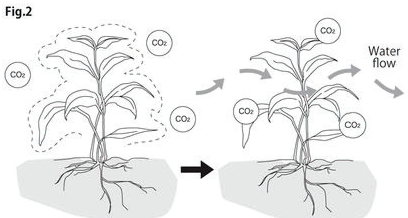Basically, when the light for a planted aquarium is made brighter, the CO2 supply amount needs to be increased accordingly. Sufficient amounts of CO2 is particularly essential for the healthy growth of sun-loving stem plants that vigorously perform photosynthesis and grow large over a short period of time. If CO2 is insufficient in an aquarium with lush aquatic plants, the plant’s photosynthesis may be disrupted by a sudden rise in pH level of aquarium water.
Under such a condition, the terminal buds of some plants, including Pogostemon, may shrink. Stem plants absorb CO2 from the surface of their leaves. If CO2 is not constantly supplied around the plant leaves at a sufficient level, a lack of CO2 will occur. To prevent this problem, it is necessary to diffuse CO2 with good diffuser and spread it across the aquarium via an appropriate rate of water flow.
In a bright environment, as shown in the aquarium data, the photosynthesis activity of stem plants becomes more vigorous with a rise in CO2 level.
The photosynthesis status can be checked by the air bubbles formed on the stem plant leaves. If you wish to supply CO2 more precisely, then use of CO2 Drop Checker is an effective solution. When CO2 is supplied to the aquarium, the pH level of the water declines (i.e., the water becomes more acidic); but if aquatic plants are actively engaged in photosynthesis, the CO2 in the water is consumed and consequently the pH level rises. This, in theory, means that there will not be any change in pH as long as the CO2 consumption rate and CO2 supply amount are perfectly balanced. Nevertheless, the CO2 level should be set slightly higher than the level exactly sufficient for the CO2 amount to be consumed for the plants. It is because the timing of CO2 supply and consumption are not synchronized with each other in an actual aquarium environment and a local lack of CO2 may occur, particularly in the area around stem plants.
For this purpose, it is advised to control the CO2 supply amount in such way that the pH level indicates mildly acidic in 4 ~ 5 Hrs after the light is turned on, which is when the photosynthesis of the plants reaches its peak. The change in pH level induced by CO2 supply and photosynthesis can be easily checked by the Drop Checker installed in the aquarium. If aeration is performed during the night, the pH level immediately before the light is turned on should usually be neutral to mildly acidic and the reagent of Drop Checker is blue in color. When the light is turned on and CO2 supply is started, the pH level gradually lowers. If the reagent color of Drop Checker is green in 4 ~ 5 Hrs after the light is turned on, it can be determined that the amount of CO2 supply is appropriate. If the reagent color is blue or yellow at this time, insufficient or excessive CO2 supply is suspected, respectively.
Aside from pH, the condition of the water quality is a factor closely related to the growth of stem plants, including the total hardness (TH or GH) and carbonate hardness (KH). Stem plants basically grow better at low water hardness, in both TH and KH, except for Hemianthus species that do not grow well under excessively low water hardness conditions. Aqua Soil in general has a tendency to lower the water hardness. When growing stem plants that do not withstand low water hardness, it is advisable to use stones as a composition material or apply Potassium everyday to maintain a certain level of hardness.
On the other hand, when the water hardness is too high, then, problems such as bleached new buds and poor growth of stem plants are observed. In this event, the total hardness can be lowered effectively by using RO water and Tap water mixed in the aquarium. The water hardness needs to be maintained at a medium level when growing Hemianthus species that do not grow well if the water hardness is too low or too high.
For information on the water quality appropriate for each aquatic plant, refer to the “Stem Plant Encyclopedia” in the Aquatic Plants section (under developemen)
